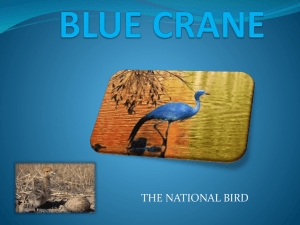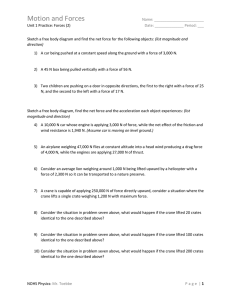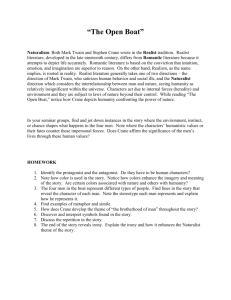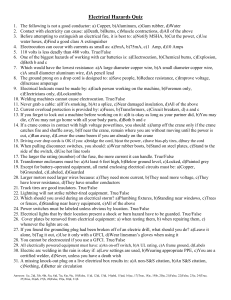03. High Risk Work Licensing for Bridge and
advertisement
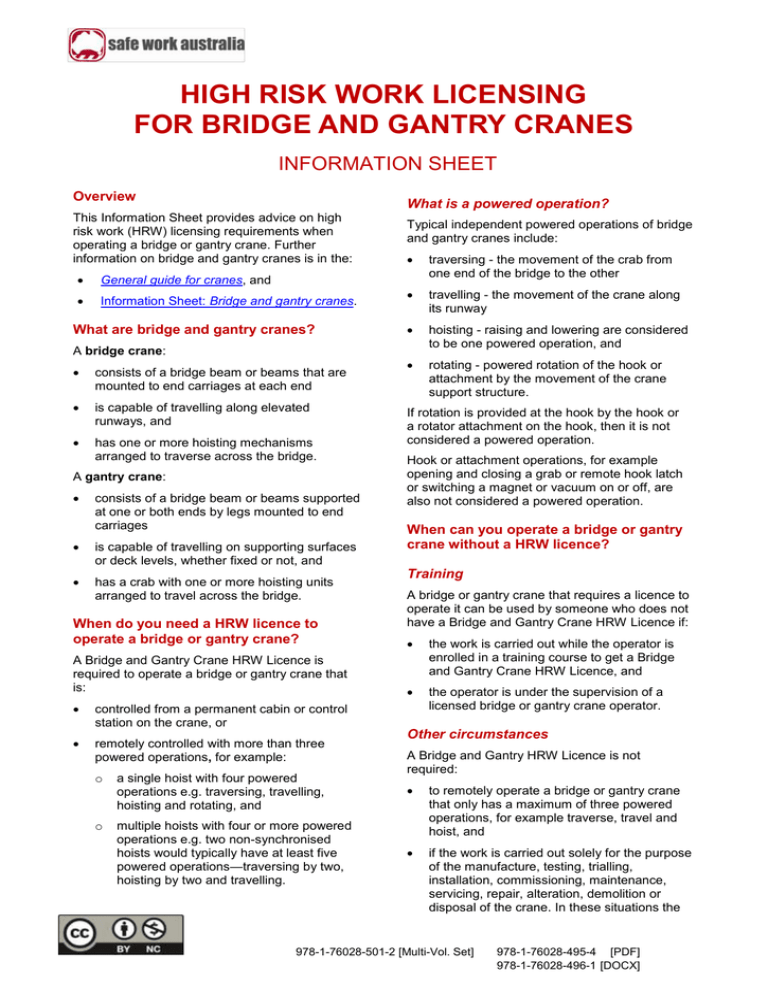
HIGH RISK WORK LICENSING FOR BRIDGE AND GANTRY CRANES INFORMATION SHEET Overview What is a powered operation? This Information Sheet provides advice on high risk work (HRW) licensing requirements when operating a bridge or gantry crane. Further information on bridge and gantry cranes is in the: General guide for cranes, and Information Sheet: Bridge and gantry cranes. What are bridge and gantry cranes? A bridge crane: consists of a bridge beam or beams that are mounted to end carriages at each end is capable of travelling along elevated runways, and has one or more hoisting mechanisms arranged to traverse across the bridge. A gantry crane: consists of a bridge beam or beams supported at one or both ends by legs mounted to end carriages is capable of travelling on supporting surfaces or deck levels, whether fixed or not, and has a crab with one or more hoisting units arranged to travel across the bridge. When do you need a HRW licence to operate a bridge or gantry crane? A Bridge and Gantry Crane HRW Licence is required to operate a bridge or gantry crane that is: controlled from a permanent cabin or control station on the crane, or remotely controlled with more than three powered operations, for example: o o a single hoist with four powered operations e.g. traversing, travelling, hoisting and rotating, and multiple hoists with four or more powered operations e.g. two non-synchronised hoists would typically have at least five powered operations—traversing by two, hoisting by two and travelling. Typical independent powered operations of bridge and gantry cranes include: traversing - the movement of the crab from one end of the bridge to the other travelling - the movement of the crane along its runway hoisting - raising and lowering are considered to be one powered operation, and rotating - powered rotation of the hook or attachment by the movement of the crane support structure. If rotation is provided at the hook by the hook or a rotator attachment on the hook, then it is not considered a powered operation. Hook or attachment operations, for example opening and closing a grab or remote hook latch or switching a magnet or vacuum on or off, are also not considered a powered operation. When can you operate a bridge or gantry crane without a HRW licence? Training A bridge or gantry crane that requires a licence to operate it can be used by someone who does not have a Bridge and Gantry Crane HRW Licence if: the work is carried out while the operator is enrolled in a training course to get a Bridge and Gantry Crane HRW Licence, and the operator is under the supervision of a licensed bridge or gantry crane operator. Other circumstances A Bridge and Gantry HRW Licence is not required: to remotely operate a bridge or gantry crane that only has a maximum of three powered operations, for example traverse, travel and hoist, and if the work is carried out solely for the purpose of the manufacture, testing, trialling, installation, commissioning, maintenance, servicing, repair, alteration, demolition or disposal of the crane. In these situations the 978-1-76028-501-2 [Multi-Vol. Set] 978-1-76028-495-4 [PDF] 978-1-76028-496-1 [DOCX] bridge or gantry crane must be operated or used without a load except when standard weight loads with predetermined fixing points are used for calibration of the crane. They also cannot: operate the bridge or gantry crane when the load is out of the operator's view, and direct another bridge or gantry crane operator in the movement of a load when the load is out of the operator's view. Are doggers required when using a bridge or gantry crane? A Dogging HRW Licence or one of the three rigging HRW licences1 is required by: In these circumstances a dogger is required to direct the crane operator. any person other than a licensed bridge or gantry crane operator, who exercises judgement in the estimation of a load or selection of the slinging method and lifting equipment when slinging a load on any bridge or gantry crane, or Table 1 lists examples of whether a dogger is required for bridge and gantry crane operations. any person who directs any bridge or gantry crane operator in the movement of the load where the load is out of view of the crane operator. Using pre-determined slinging methods What does ‘exercise judgement’ mean? To exercise judgement means making decisions when: selecting the slinging method by considering the size and shape of the load selecting the lifting gear by determining the weight (its mass) and centre of gravity of the load, and inspecting the lifting gear to ensure it is not defective by considering its condition. The Bridge and Gantry Crane HRW Licence includes the application of load estimation and slinging techniques to move a load competently. Holders of a Bridge and Gantry Crane HRW Licence can exercise judgement on the load and slinging method and select and inspect lifting equipment when operating a bridge or gantry crane. Holders of a Bridge and Gantry Crane HRW Licence cannot exercise judgement or inspect lifting gear for any other class of crane unless they hold the relevant HRW licence. Further information on dogging work is in the Information Sheet: High risk work licensing for dogging. The selection of the slinging method and the lifting gear can be pre-determined by a competent person and set out in a safe work lifting procedure, for example where high volume repetitive lifting occurs. A competent person includes a dogger, rigger or an engineer experienced in designing safe work lifting procedures. A safe work lifting procedure is a documented procedure that defines the details of a lift including the: weight of the load lifting points equipment and resources used procedures relating to differing weather and site conditions, and system for regular inspection of the lifting gear. If unlicensed workers are to use pre-determined slinging techniques to sling loads they must receive training, instruction and information to correctly follow the specific safe work lifting procedures. Table 1 lists examples of who is able to sling the load for bridge and gantry crane operations. Further information 1 There are three rigging HRW licences. They are the Basic Rigging HRW Licence, Intermediate Rigging HRW Licence and the Advanced Rigging HRW Licence. Licensed riggers must have completed the Dogging Unit of Competency to get their rigging HRW licence. They are therefore able to legally carry out dogging work. In this Information Sheet the term dogger is taken to include rigger. For further information see the Safe Work Australia website (www.swa.gov.au). Information Sheet: High risk work licensing for bridge and gantry cranes December 2015 Page 2 of 3 Table 1 Examples of bridge and gantry crane operation, operator licensing and dogging requirements Operation and crane licence Dogging, slinging and directing requirements A cabin-operated bridge crane is used to move items like cable spools, power poles and concrete pipes at an electricity supplier depot. Who can sling the load? Different slinging techniques are required and the lifting gear has not been specifically chosen for each lift. Who cannot sling the load? Workers with a Bridge and Gantry HRW Licence. A dogger. The bridge crane operator—while they can leave the cabin to sling the load they need to carry out a test lift which involves checking the slings when the crane is under load. This check is not possible because they are not able to leave the controls (cabin) while the crane is under load. Other workers—judgement in slinging techniques is required. Development of the safe work lifting procedures for other workers is not possible. Other crane operators—mobile crane and other crane operators cannot sling loads unless they have a Dogging HRW Licence. Loads can be seen by the operator throughout the lift for all lifts. Is a Bridge and Gantry HRW Licence required? Yes, the bridge crane is operated from a permanent cabin on the crane. Is a dogger required to direct the load? A dogger is not required because the crane operator can see the load throughout the lift. A remote operated gantry crane with four powered operations is used to move steel plates in a shipyard. Loads are repetitive, safe work lifting procedures have been developed and training provided. Loads can be seen by the operator throughout the lift for all lifts. Is a Bridge and Gantry HRW Licence required? Yes, the gantry crane is remotely controlled and has more than three powered operations. Who is able to sling the load? The gantry crane operator. Another worker with a Bridge and Gantry HRW Licence. A dogger. Other workers who have been trained and assessed in the safe work lifting procedures. Who is not able to sling the load? Other workers who have not been trained in the safe work lifting procedures. Other crane operators because mobile crane and other crane operators cannot sling loads unless they have a Dogging HRW Licence or have been trained and assessed in the safe work lifting procedures. Is a dogger required to direct the load? A dogger is not required because the crane operator can see the load throughout the lift. A remote operated gantry crane with three powered operations is used to move components in a factory. Loads are repetitive, safe work lifting procedures have been developed and training provided. Loads cannot be seen by the operator throughout lifts. Is a Bridge and Gantry HRW Licence required? No, the gantry crane does not have more than three powered operations. Who is able to sling the load? Workers with a Bridge and Gantry HRW Licence. A dogger. Other workers who have been trained and assessed in the safe work lifting procedures. Who is not able to sling the load? Other workers who have not been trained in the safe work lifting procedures. Is a dogger required to direct the load? A dogger is required because the crane operator cannot see the load throughout the lift. Information Sheet: High risk work licensing for bridge and gantry cranes December 2015 Page 3 of 3
